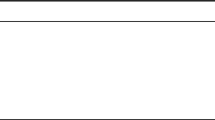Abstract
Applications of signed digit representations of an integer include computer arithmetic, cryptography, and digital signal processing. An integer of length n bits can have several binary signed digit (BSD) representations and their number depends on its value and varies with its length. In this paper, we present an algorithm that calculates the exact number of BSDR of an integer of a certain length. We formulate the integer that has the maximum number of BSDR among all integers of the same length. We also present an algorithm to generate a random BSD representation for an integer starting from the most significant end and its modified version which generates all possible BSDR. We show how the number of BSD representations of k increases as we prepend 0s to its binary representation.
Similar content being viewed by others
References
Cohen H, Miyaji A, Ono T (1998) Efficient elliptic curve exponentiation using mixed coordinates. In: Advances in Cryptology—ASIACRYPT ’98. vol 1514. LNCS, Springer-Verlag, Berlin, pp 51–65
Ebeid N, Hasan MA (2003) Analysis of DPA countermeasures based on randomizing the binary algorithm. CACR Technical Reports CORR 2003-14, University of Waterloo
Ebeid N, Hasan MA (2003) On randomizing private keys to counteract DPA attacks. In: Selected Areas in Cryptography—SAC ’03. vol 3006. LNCS, Springer-Verlag, Berlin, pp 58–72
Fouque PA, Muller F, Poupard G, Valette F (2004) Defeating countermeasures based on randomized BSD representations. In: Cryptographic Hardware and Embedded Systems—CHES ’04. vol 3156 LNCS, Springer-Verlag, Berlin, pp 312–327
Ha J, Moon S (2002) Randomized signed-scalar multiplication of ECC to resist power attacks. In: Cryptographic Hardware and Embedded Systems—CHES ’02. vol 2523 LNCS, Springer-Verlag, Berlin, pp 551–563
Kalbfleisch JG (1985) Probability and statistical inference volume 1: probability. Springer-Verlag, Berlin
López J, Dahab R (1999) Improved algorithms for elliptic curve arithmetic in GF(2n) without precomputation. In: Selected Areas in Cryptography—SAC ’98. vol 1556 LNCS, Springer-Verlag, Berlin, pp 201–212
Morain F, Olivos J (1990) Speeding up the computations on an elliptic curve using addition-subtraction chains. Informatique théorique et Applications/Theoret Informatics Appl 24(6):531–544
Oswald E, Aigner M (2001) Randomized addition-subtraction chains as a countermeasure against power attacks. In: Cryptographic Hardware and Embedded Systems—CHES ’01. vol 2162 LNCS, Springer-Verlag, Berlin, pp 39–50
Reitwiesner GW (1960) Binary arithmetic. Adv Comput 1:231–308
Sim SG, Park DJ, Lee PJ (2004) New power analysis on the Ha-Moon algorithm and the MIST algorithm. In: Information and communications security—ICICS ’04. vol 3269 LNCS, Springer-Verlag, Berlin, pp 291–304
Solinas JA (2000) Efficient arithmetic on Koblitz curves. Designs, Codes Cryptogr 19:195–249
Author information
Authors and Affiliations
Corresponding author
Rights and permissions
About this article
Cite this article
Ebeid, N., Hasan, M.A. On binary signed digit representations of integers. Des Codes Crypt 42, 43–65 (2007). https://doi.org/10.1007/s10623-006-9014-9
Received:
Accepted:
Published:
Issue Date:
DOI: https://doi.org/10.1007/s10623-006-9014-9




